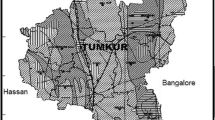Abstract
The activity concentration and the gamma-absorbed dose rates of the terrestrial naturally occurring radionuclides (232Th, 226Ra and 40K) were determined in soil samples collected from ten different locations of Sirsa district of Haryana, using HPGe detector based on high-resolution gamma spectrometry system. The range of activity concentrations of 226Ra, 232Th and 40K in the soil samples from the studied areas varies from 19.18 Bq kg−1 (Moriwala) to 40.31 Bq kg−1 (Rori), 59.43 Bq kg−1 (Pipli) to 89.54 Bq kg−1 (Fatehpur) and 223.22 Bq kg−1 (Moriwala) to 313.32 Bq kg−1 (SamatKhera) with overall mean values of 27.94, 72.75 and 286.73 Bq kg−1 respectively. The absorbed dose rate calculated from activity concentration of 226Ra, 232Th and 40K ranges between 8.84 and 18.58, 37.02 and 55.78, and 9.24 and 12.97 nGy h−1, respectively. The total absorbed dose in the study area ranges from 60.40 to 82.15 nGy h−1 with an average value of 70.12 nGy h−1. The calculated values of external hazard index (H ex) for the soil samples of the study area range from 0.36 to 0.49 with an average value of 0.42.

Similar content being viewed by others
References
Bennett BG (1997) Exposure to natural radiation worldwide. In: Proceedings of the fourth international conference on high levels of natural radiation: radiation doses and health effects, Beijing, China, 1996, Elsevier, Tokyo
Beretka J, Mathew PJ (1985) Natural radioactivity of Australian building materials, industrial wastes and by-products. Health Phys 48:87–95
Chougankar MP, Eppen KP, Ramachandran TV (2003) Profiles of doses to population living in the high background radiation areas in Kerala. J Environ Radioact 71:275–295
European Commission. Radiation Protection 112 (1999) Radiological protection principles concerning the natural radioactivity of building materials, Brussels, European Commission
ICRP, International Commission on Radiological Protection (1993) ICRP publication 65, Annals of the ICRP 23(2). Pergamon Press, Oxford
Jacob P, Paretzke HG, Rosenbaum H, Zankl M (1986) Effective dose equivalents for photon exposure from plane sources on the ground. Radiat Prot Dosim 14:299–310
Kocher DC, Sjoreen AL (1985) Dose-rate conversion factors for external exposure to photon emitters in soil. Health Phys 48:193–205
Leung KC, Lau SY, Poon CB (1990) Gamma radiation dose from radionuclides in Hong Kong soil. J Environ Radioact 11:279–290
Mehra R, Singh S, Singh K (2006) A study of uranium, radium, radon exhalation rate and indoor radon in the environs of some areas of Malwa region, Punjab. Indoor Built Environ 5:499–505
Mehra R, Singh S, Singh K, Sonkawade R (2007) 226Ra, 232Th and 40K analysis in soil samples from some areas of Malwa region, Punjab, India using gamma ray spectroscopy. Environ Monit Assess 134:333–342
Nageswara Rao MV, Bhatti SS, Rama Seshu P, Reddy AR (1996) Natural radioactivity in soil and radiation levels of Rajasthan. Radiat Prot Dosim 63:207–216
Organization for Economic Cooperation and Development. (1979). Exposure to radiation from the natural radioactivity in building materials. Report by a group of experts of the OECD Nuclear Energy Agency, OECD, Paris, France
Paul AC, Pillai PMB, Haridasan P, Radhakrishnan S, Krishnamony S (1998) Population exposure to airborne thorium at the high natural radiation areas in India. J Environ Radioact 40:251–259
Quindos LS, Fernandez PL, Soto J, Rodenos C, Gomez J (1994) Natural radioactivity in Spanish soils. Health Phys 66:194–200
Radhakrishna AP, Somasekarapa HM, Narayana Y, Siddappa K (1993) A new natural background radiation area on the southwest coast of India. Health Phys 65:390–395
Singh S, Mehra R, Singh K (2005) Uranium, radium and radon exhalation studies in soil samples belonging to some areas of Punjab, using track etching technique. J Environ Sci Eng 47:85–90
UNSCEAR (1988) Sources and Effects of Ionizing Radiation. United Nations Scientific Committee on the Effect of Atomic Radiation, United Nations, New York
UNSCEAR (1993) Sources and Effects of Ionizing Radiation. United Nations Scientific Committee on the Effect of Atomic Radiation, United Nations, New York
UNSCEAR (2000) United Nations Scientific Committee on the effects of atomic radiation. Effects and risks of ionizing radiations. United Nations, New York
Yu KN, Guan ZJ, Stoks MJ, Young EC (1992) The assessment of natural radiation dose committed to the Hong Kong people. J Environ Radioac 17:31–48
Acknowledgments
The authors are thankful to the residents of the study area for their cooperation during the fieldwork, and the officials of Health Physics Lab of Inter University Accelerator Centre, New Delhi for their support in providing the necessary equipments for gamma ray spectrometry.
Author information
Authors and Affiliations
Corresponding author
Rights and permissions
About this article
Cite this article
Mehra, R., Kumar, S., Sonkawade, R. et al. Analysis of terrestrial naturally occurring radionuclides in soil samples from some areas of Sirsa district of Haryana, India using gamma ray spectrometry. Environ Earth Sci 59, 1159–1164 (2010). https://doi.org/10.1007/s12665-009-0108-3
Received:
Accepted:
Published:
Issue Date:
DOI: https://doi.org/10.1007/s12665-009-0108-3




